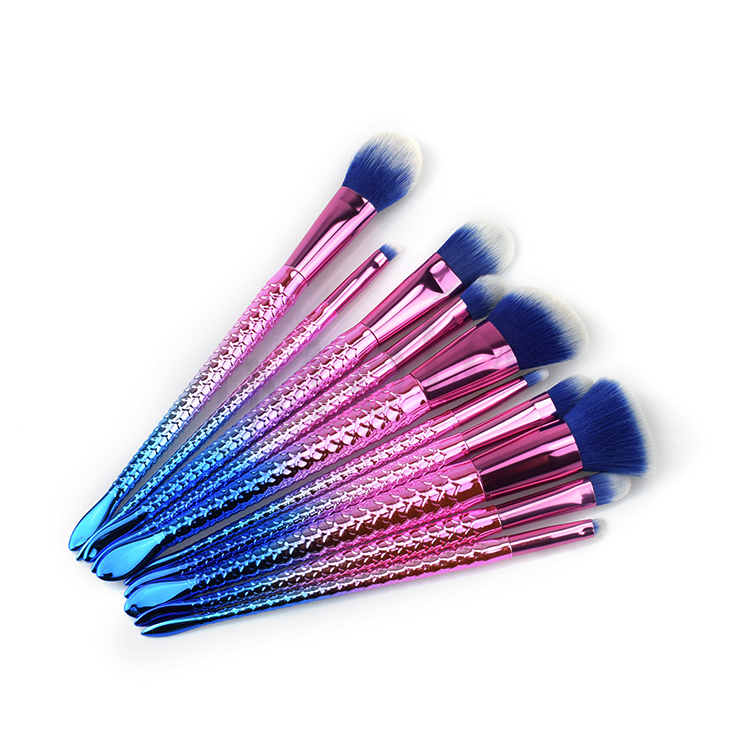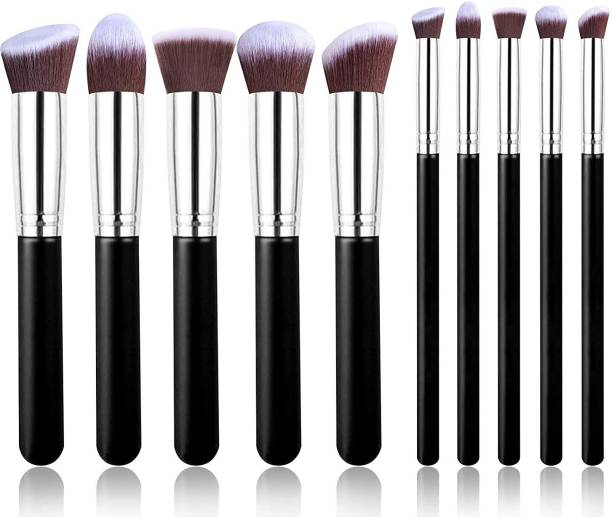Natural vs Synthetic Makeup Brushes
The tools of the beauty trade are many and varied, but in general, makeup brushes can be divided into two categories: natural and synthetic. Hare's feet may no longer be in circulation for makeup application, but if the idea of setting your makeup with squirrel fur gives you the creeps, it pays to be informed as to the construction, material, source and particular specialism of the brushes in your kit. Here's the lowdown on the two main brush types, along with a few pros and cons to consider.
Makeup Brush Construction
First of all, you need to understand the structure of makeup brush, we will introduce it in detail below.
Bristles
The toe is the bristle tips -the bit that goes on the skin.
The heel is the bottom end of the bristles. Here, the bristles are tied and then glued in the ferrule. Some ferrules are also clamped tightly around the bristle heel.
The length, softness, shape, and amount of hairs used in a brush are dictated by what makeup products the brush has been designed for.
Ferrule
The bristles are held in place by the ferrule, which is sometimes pinched flat.
The ferrule is usually metal, such as nickel-plated brass or aluminium. The ferrule can also be plastic.
The bottom of the ferrule is glued to the handle to make it secure. It is best to not leave brushes in water or let water get into the ferrule.
Handle
Handles are made from solid materials, such as wood (coated in either varnish or paint), resin or plastic.
Recycled or sustainable materials (like bamboo) can also be used to make brush handles. They are growing in availability and popularity due to having less impact on the environment.
Printed on the handle can be various information, including the brand logo and the brush's purpose or size. It varies from brand to brand.
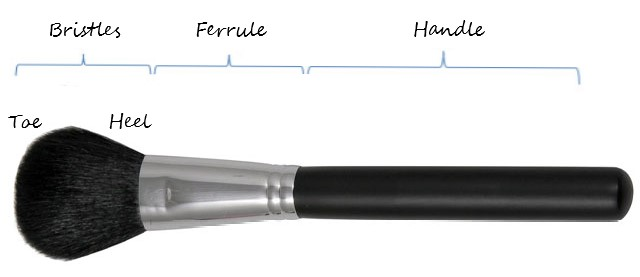
Material of makeup bristles
The material of makeup is mainly distinguished by the material of the bristles. So how do we differentiate between these two main bristle materials?
Animal Hair
Animal hair (sometimes referred to as natural) comes from animals, including goats, badgers, squirrels, weasels ("sable"), and horses ("pony"). Camel hair brushes are not camel hair but a combination of several types of animal hair (including horse, goat and squirrel) – it depends on the desired softness and cost.
The hair has a cuticle, a layered outer coating on the hair shaft, which picks up and distributes powder products well. The cuticle also means that animal hair is not so good for cream, gel or liquid products, as it picks up too much product and can lead to clogging, blobs or streaking.
Each type of hair comes with unique strengths and advantages. For example, sable hair is soft, flexible and goes to a fine point – suitable for precision work. Badger hair is stiff and used in brushes that work to define and shape, like brow brushes. Squirrel and goat hair is very soft.
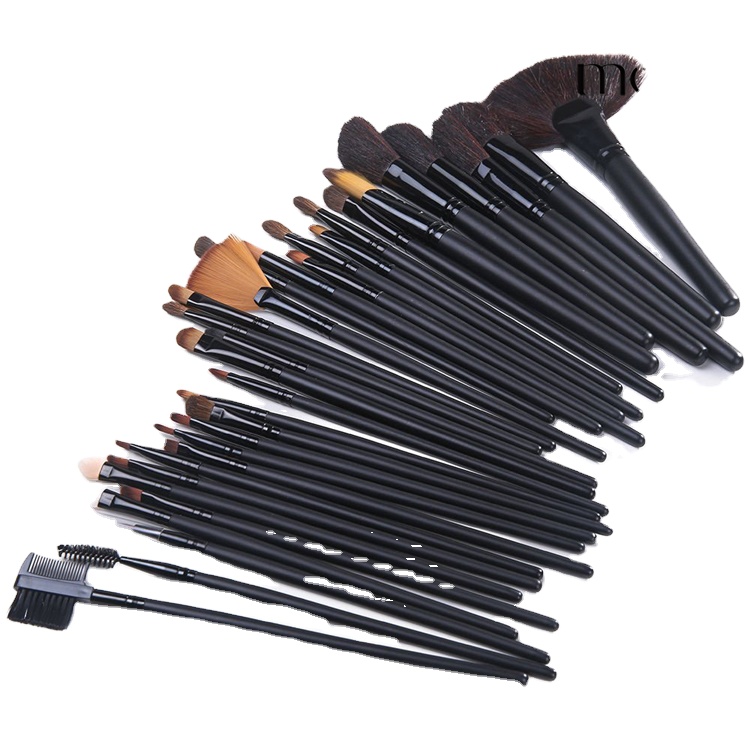
Synthetic Hair
Synthetic hair is 100% manufactured fibers, like nylon and polyester. Synthetic hair does not have a cuticle, so it is very smooth and traps less product in the hair than animal hair brushes. Therefore, they are great for creams, gels and liquids. Powders can also be applied with synthetics designed just for this purpose. For example, Taklon and Natrafil were designed to mimic the different properties of animal hair, making them suitable substitutes for powder cosmetics.
The hair is made in factories – and can be cut to any length and dyed to any colour. And here are types of synthetic fibers used in makeup brushes:
Taklon – is a soft, smooth polyester derivative – developed by DuPont to mimic the qualities of natural sable. Therefore, it is soft and flexible with a good point. It is an incredibly versatile material and can create bristles in all types and sizes of makeup brushes.
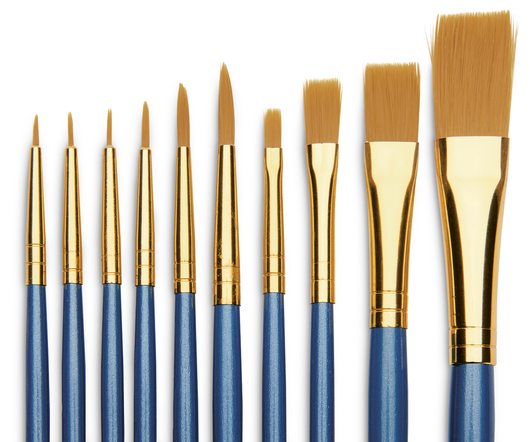
Nylon – has smooth fibres and is used in makeup brushes that need a degree of firmness to the bristles, like concealer, brow and mascara brushes.
Natrafil – is another DuPont creation, initially designed to replace animal hair for use in powder brushes. Here, it is essential to pick up the powder product and release it evenly over the skin. Natrafil® is a polyester-based composite made with a textured surface, allowing the hair to grab the powder. The commonly held belief that synthetics are no good for powder makeup is no longer so with this type of bristles.
What kind of brushes should we use?
It's been the case that natural brushes are softer and fluffier than their synthetic sisters. In general natural brushes are known to pick up powder pigment more effectively and blend it into the skin with less work on your part. This 'absorption' of product is thanks to the porous cuticle structure present in natural hair, and the polished finish when used with powder is the reason that many makeup artists deem natural blusher, bronzer and powder brushes essential to their professional arsenal. In general if you use natural brushes you'll experience less product "fall out", as powder traditionally clings better to natural bristles. And well-made natural brushes are conventionally thought to be good long term investments due to the durability of natural hair fibres.
But they're often incompatible with cream products. The permeable quality of natural brush brushes is a big detractor when it comes to cream products; natural brushes will absorb your precious liquid foundation, cream blusher and highlighter fluid. The fact that the bristles drink up makeup also means that a natural brush won't apply cream products evenly.
Synthetic brushes can be advantageous in certain ways, like when it comes to maintenance. They also don't damage the way natural hair ones do over time as they are washed over and over again, synthetic brushes can also be sanitized with alcohol without drying the hairs, which is another benefit over natural-hair brushes.
Many makeup artists say there's a difference between how natural and synthetic brushes work and use them for specific purposes based on that difference.
We can use synthetic brushes with cream and liquid makeup and natural brushes with powders. Talc based products get better pick up with natural fibers because its so fine and, like hair, the natural bristles are more porous, synthetics don't have a cuticle so it tends to be better with creams and liquids because there's no absorption.
When we need a smoother, more blendable application, for example, gel or oil based products (usually smaller, firmer detail brushes for eyes or lips), or work with a product that needs more of a push to blend (cream or full coverage foundations and large domed 'airbrush effect' brushes); we can use synthetic brushes for their dense and even application and because they last better after washing those products out, When we use natural-fiber brushes, we are typically diffusing powder or soft cream shadows, blush, or very lightly blending concealer with moderately densely bound hairs in flat or dome shaped brushes.
In conclusion, natural brushes are used mostly to work with dry pigments such as loose press powders, blushes, eyeshadows and synthetic brushes are used mostly to work with creams these are foundations concealers cream blushes and cream eyeshadows.
How to distinguish different kind of brushes?
In order to distinguish if it is a natural or synthetic brush you can look at the brush in the light you will see that natural and synthetic brushes reflect light differently. Synthetic fibers reflect light more than a natural bristle.
Another and probably the main difference by which you can unmistakably tell a synthetic brush from a natural brush is its strength. You can not tear synthetic bristle with your fingers even if you try quite hard you can only bend it out of shape if you pull at one hair real hard but normally you would need scissors to cut it off while natural hair can be torn with just a little stronger pull if you can do that it means the brush is made of natural bristle but of course it is better not to use this method to often, learn to see the difference of natural and synthetic bristle by just looking at how they reflect light.

